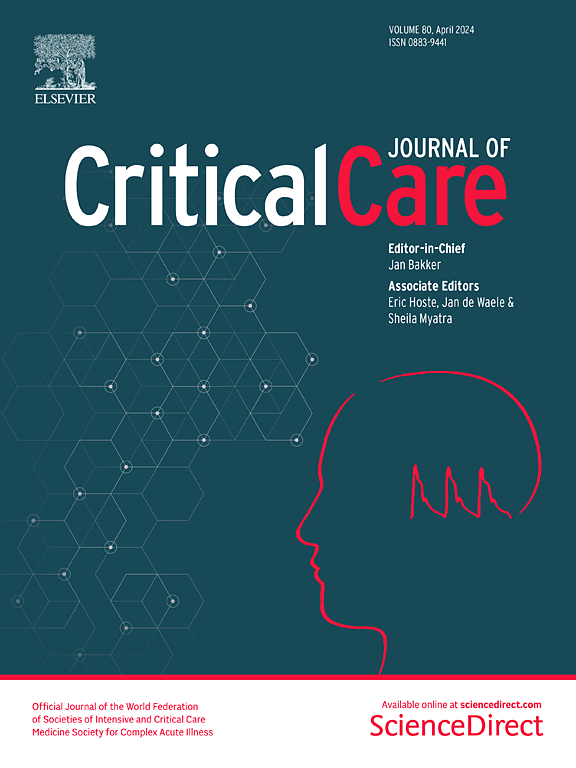在儿科重症监护中,高流量鼻插管疗法与持续气道正压疗法在无创呼吸支持方面的成本效益比较
IF 8.8
1区 医学
Q1 CRITICAL CARE MEDICINE
引用次数: 0
摘要
高流量鼻插管疗法(HFNC)和持续气道正压(CPAP)是儿科重症监护病房广泛使用的两种无创呼吸支持模式。FIRST-ABC 随机对照试验(RCTs)评估了 HFNC 与 CPAP 在两种不同重症监护人群中的临床和成本效益比较:急性病儿童("加强型 "RCT)和拔管儿童("降低型 "RCT)。临床效果(脱离各种形式呼吸支持的时间)结果显示,在 "加强 "研究中,HFNC 的效果不优于 CPAP,但在 "减弱 "研究中,HFNC 未达到非劣效性标准。本研究评估了 HFNC 与 CPAP 的成本效益。使用 FIRST-ABC RCTs 数据报告了全因死亡率、健康相关生活质量 (HrQoL) 和长达 6 个月的成本。HrQoL 采用与年龄相适应的儿科生活质量通用核心量表问卷进行测量,并在 6 个月后映射到儿童健康效用 9D 指数得分上。质量调整生命年 (QALY) 是通过将 HrQoL 与死亡率相结合来估算的。通过测量和估价儿科重症监护室、普通病房和更广泛的医疗服务所使用的医疗资源,计算出六个月时的成本。成本效益分析使用回归方法报告了高频NC与CPAP在六个月内的成本效益,并总结了增量成本效益结果的不确定性。在两项研究中,随机分组在六个月时的增量 QALYs 相似。降级RCT和升级RCT在6个月时的估计增量成本分别为-4565英镑(95% CI-11499英镑至2368英镑)和-5702英镑(95% CI-11328英镑至-75英镑)。在降级 RCT 和升级 RCT 中,HFNC 相对于 CPAP 的增量净效益分别为 4388 英镑(95% CI - 2551 英镑至 11,327 英镑)和 5628 英镑(95% CI - 8 英镑至 11,264 英镑)。成本效益结果存在相当大的不确定性。大多数预先指定的亚组的结果相似,基础病例结果对其他假设是稳健的。与 CPAP 相比,HFNC 作为儿科重症监护病房危重患儿的无创呼吸支持可降低平均成本,在总体上和主要亚组中具有相对较高的成本效益,但这一结果在统计学上存在相当大的不确定性。本文章由计算机程序翻译,如有差异,请以英文原文为准。
Cost-effectiveness of high flow nasal cannula therapy versus continuous positive airway pressure for non-invasive respiratory support in paediatric critical care
High flow nasal cannula therapy (HFNC) and continuous positive airway pressure (CPAP) are two widely used modes of non-invasive respiratory support in paediatric critical care units. The FIRST-ABC randomised controlled trials (RCTs) evaluated the clinical and cost-effectiveness of HFNC compared with CPAP in two distinct critical care populations: acutely ill children (‘step-up’ RCT) and extubated children (‘step-down’ RCT). Clinical effectiveness findings (time to liberation from all forms of respiratory support) showed that HFNC was non-inferior to CPAP in the step-up RCT, but failed to meet non-inferiority criteria in the step-down RCT. This study evaluates the cost-effectiveness of HFNC versus CPAP. All-cause mortality, health-related Quality of Life (HrQoL), and costs up to six months were reported using FIRST-ABC RCTs data. HrQoL was measured with the age-appropriate Paediatric Quality of Life Generic Core Scales questionnaire and mapped onto the Child Health Utility 9D index score at six months. Quality-Adjusted Life Years (QALYs) were estimated by combining HrQoL with mortality. Costs at six months were calculated by measuring and valuing healthcare resources used in paediatric critical care units, general medical wards and wider health service. The cost-effectiveness analysis used regression methods to report the cost-effectiveness of HFNC versus CPAP at six months and summarised the uncertainties around the incremental cost-effectiveness results. In both RCTs, the incremental QALYs at six months were similar between the randomised groups. The estimated incremental cost at six months was − £4565 (95% CI − £11,499 to £2368) and − £5702 (95% CI − £11,328 to − £75) for step-down and step-up RCT, respectively. The incremental net benefits of HFNC versus CPAP in step-down RCT and step-up RCT were £4388 (95% CI − £2551 to £11,327) and £5628 (95% CI − £8 to £11,264) respectively. The cost-effectiveness results were surrounded by considerable uncertainties. The results were similar across most pre-specified subgroups, and the base case results were robust to alternative assumptions. HFNC compared to CPAP as non-invasive respiratory support for critically-ill children in paediatric critical care units reduces mean costs and is relatively cost-effective overall and for key subgroups, although there is considerable statistical uncertainty surrounding this result.
求助全文
通过发布文献求助,成功后即可免费获取论文全文。
去求助
来源期刊

Critical Care
医学-危重病医学
CiteScore
20.60
自引率
3.30%
发文量
348
审稿时长
1.5 months
期刊介绍:
Critical Care is an esteemed international medical journal that undergoes a rigorous peer-review process to maintain its high quality standards. Its primary objective is to enhance the healthcare services offered to critically ill patients. To achieve this, the journal focuses on gathering, exchanging, disseminating, and endorsing evidence-based information that is highly relevant to intensivists. By doing so, Critical Care seeks to provide a thorough and inclusive examination of the intensive care field.
 求助内容:
求助内容: 应助结果提醒方式:
应助结果提醒方式:


